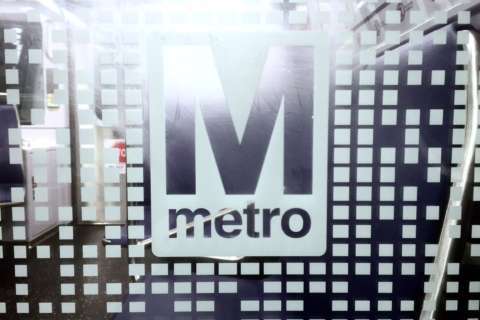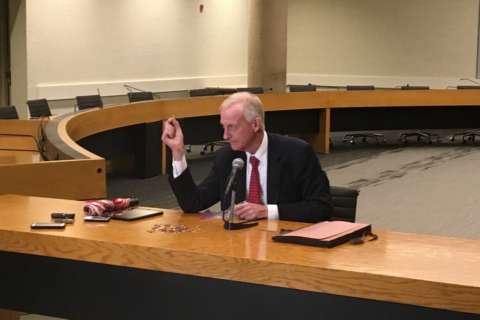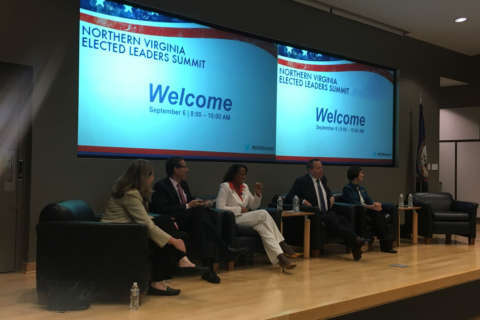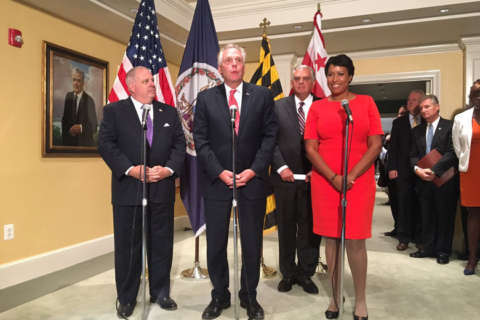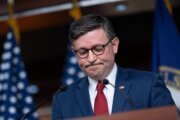WASHINGTON — Regional leaders vowed Wednesday to keep pushing for new dedicated tax revenue for Metro in the face of dire new fiscal threats outlined by the general manager, even as the likelihood of a long-term deal getting approval this winter dims.
In a presentation set to be given to the Metro Board Thursday, General Manager Paul Wiedefeld will repeat his warning that $500 million per year in new, dedicated capital funding is needed by next fall to avoid significant cuts or other problems. That’s in addition to any funding increases needed for operations.
“I remain fully committed to a long-term solution of dedicated funding of the amount we know we would need … [but] it is possible that we won’t achieve that … this year,” Montgomery County Council President Roger Berliner said.
Fairfax County board of supervisors Chairman Sharon Bulova, the chair of a regional Metro Strategy Group that had originally hoped to report an agreement in principle this week on how to get Metro $500 million in annual capital funding, told the Metropolitan Council of Governments “we still have some work to do” but it is not time to give up on a 10-year funding plan for major Metro maintenance and repairs.
Maryland Gov. Larry Hogan said in a letter Monday that the state would commit $125 million from its budget each year for the next four years if, and only if, Virginia, D.C. and the federal government matched the funding increase. It is not clear whether the federal government will even extend the existing $150 million per year in special capital contributions to Metro that are set to expire.
Under Hogan’s proposal, including the proposed increase from $150 million to $375 million in special federal Metro funding, Metro believes it could meet its capital funding needs from July 2018 to July 2020, with a small gap the following year that would jump significantly in the years beyond that if contributions returned to previous levels.
A dire picture
Thursday’s presentation paints a dire picture of Metro’s capital funding. Without new dedicated tax dollars, it projects a need for a near-tripling of local governments’ capital contributions in the next budget year.
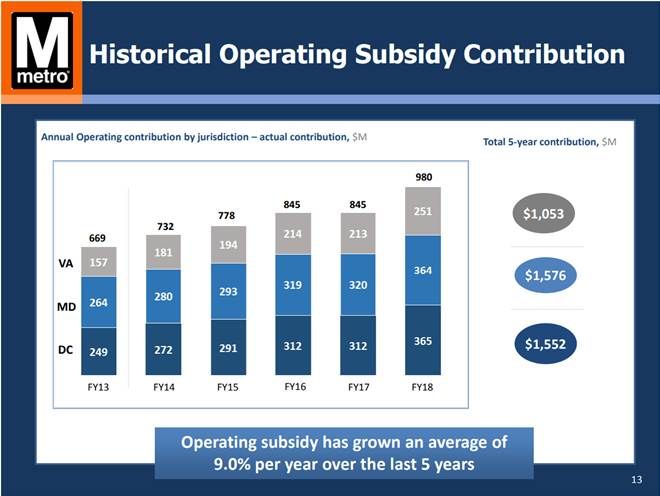
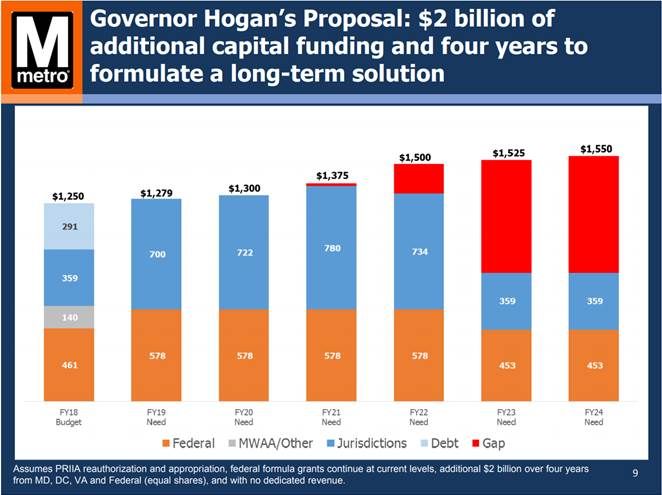
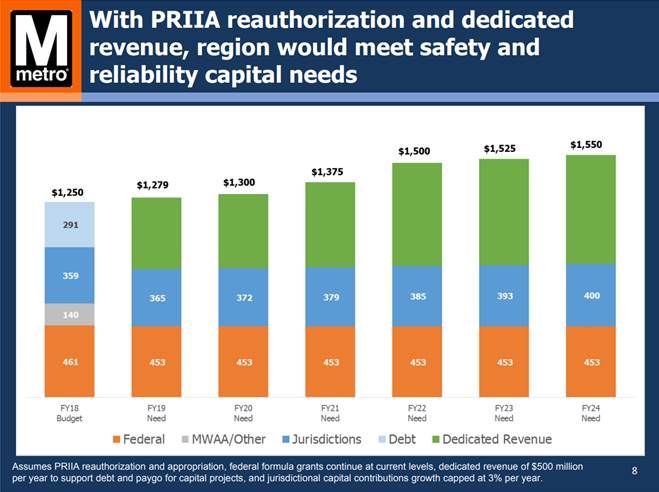
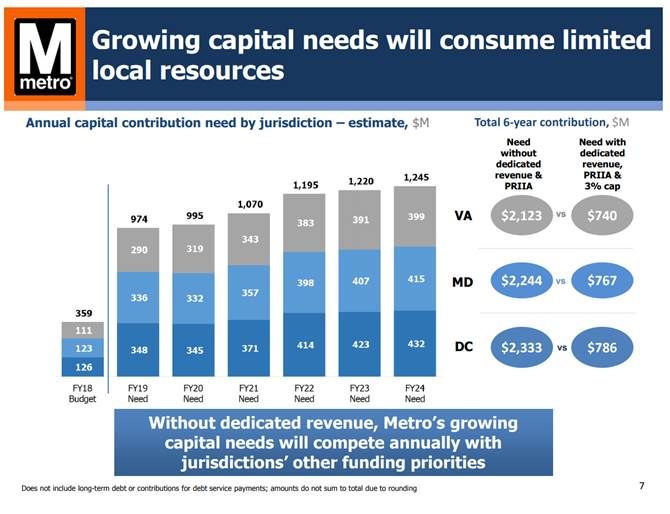
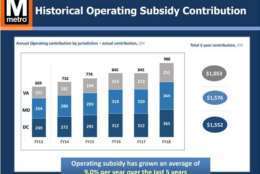

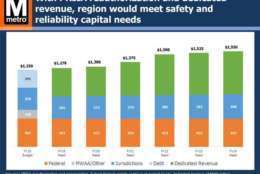

With the new tax dollars and continued federal contributions Wiedefeld has pushed for, Metro has promised local government payments would grow no more than 3 percent each year.
On the operating side, without any changes for the budget year that begins in July 2018, Wiedefeld projects Maryland, D.C. and local governments in Virginia would pay at least $866 million more in operating contributions over the next six years than they would if his proposed changes were implemented, not factoring in the results of ongoing contract negotiations with Metro’s largest union, which recently went into arbitration.
The projections do include Metro’s expectation that revenue from riders and other sources will drop in the budget year starting next summer, and will not recover to current levels until at least July 2021. Increased advertising sales, fare evasion crackdowns, more reliable and efficient service, new development at stations and continued service cuts for more direct bus routes or privately operated service are all among options to increase potential income.
The promised 3 percent cap would not apply to new services beyond what is offered Thursday, such as the second phase of the Silver Line set to open around 2020, the Potomac Yard Station in Alexandria that will likely open in 2021, a return to longer operating hours, additional bus routes or the required money for pensions and other post-employment benefits that the Metro Board underfunded for years.
Still, Wiedefeld is set to warn that he cannot limit operating subsidy growth to the promised 3 percent per year, even for current services, “without regional support of transformative changes.”
“[It] requires reform of arbitration process, new retirement program for new hires, competitive contracting and a rainy-day fund,” the presentation said.
Virginia State Sen. George Barker hopes changes including a potentially smaller Metro Board, suggested by former U.S. Transportation Secretary Ray LaHood, could help get something done. LaHood’s report is also due to address union contracts and benefits.
“I think [LaHood’s report] will help in terms of building public confidence and confidence of elected officials in Metro. That will help us immensely in terms of addressing the funding issues,” Barker said.
While Barker described Hogan’s acknowledgment that Metro needs more maintenance and repair money as promising, he said local leaders need to remain focused on a 10-year funding plan even if all the details are not finalized.
“I think that puts us in a much better position than the four-year plan that says, ‘Well, what happens after that?,’” Barker said. “I don’t want to lose the momentum that I think we have built this year on moving forward on addressing these things, and I think particularly if there’s positive results coming forward from recommendations that Secretary LaHood makes, we will be politically in a much better position.”
He believes there is an opportunity to get something done this year.
“I’ve had a lot of meetings with a lot of people in Richmond, and what I can tell you is that there are a lot of things we can’t do but there is a commitment to get done what we can, and I think we can pull things together to move forward on it, and I don’t want to give up on that to go for something that we have to come back a year or so from now and piece together,” Barker said.
A stopgap measure
Regardless, Berliner urged the region to lock in the $375 million per year annual increase from the jurisdictions in Hogan’s proposal as a potential “interim, short-term, stopgap” measure, an idea Loudoun County Supervisor Matt Letourneau agreed with.
“I think we can pursue a long-term strategy,” Letourneau said. “I don’t think we have to give up on that. But I also think it would behoove us to start thinking about what a shorter-term strategy is, because when the bills are due for the jurisdictions come this April when we’re passing our budgets, we need to know what we’re going to do with that.”
Loudoun County will join the list of Metro jurisdictions as construction on the second phase of the Silver Line to and beyond Dulles Airport is completed.
Across the region, various elected leaders each have raised their own issues with plans to provide more capital funding to Metro. In Maryland and Virginia, there are disputes over whether new taxes are warranted. In the District, D.C. Council Chairman Phil Mendelson believes the current formula for deciding which jurisdiction pays what is unfair to the city.
Mendelson and Berliner agreed that any short-term deal would not lock in that formula for a longer-term plan, but Mendelson is concerned that instead of buying more time for a deal, a short-term fix could simply end up putting off deadlines that have pushed the region closer to action after decades of neglecting the Metro system.
Prince George’s County Council Chairman Derrick Leon Davis still supports a regional sales tax, but understands any long-term deal may not be possible during this winter’s General Assembly sessions.
“A short term solution also allows us an opportunity to really dig into the needs of how we approach the bondable solution that helps carry Metro well into our next generation,” he said.
“Repeating the mistakes that we made … should not be an option at this point. We need to be thinking right now about a future when we’re all not here, and so we need to be prepared to make some very difficult decisions if we are able to even get to a very short-term solution. ”

